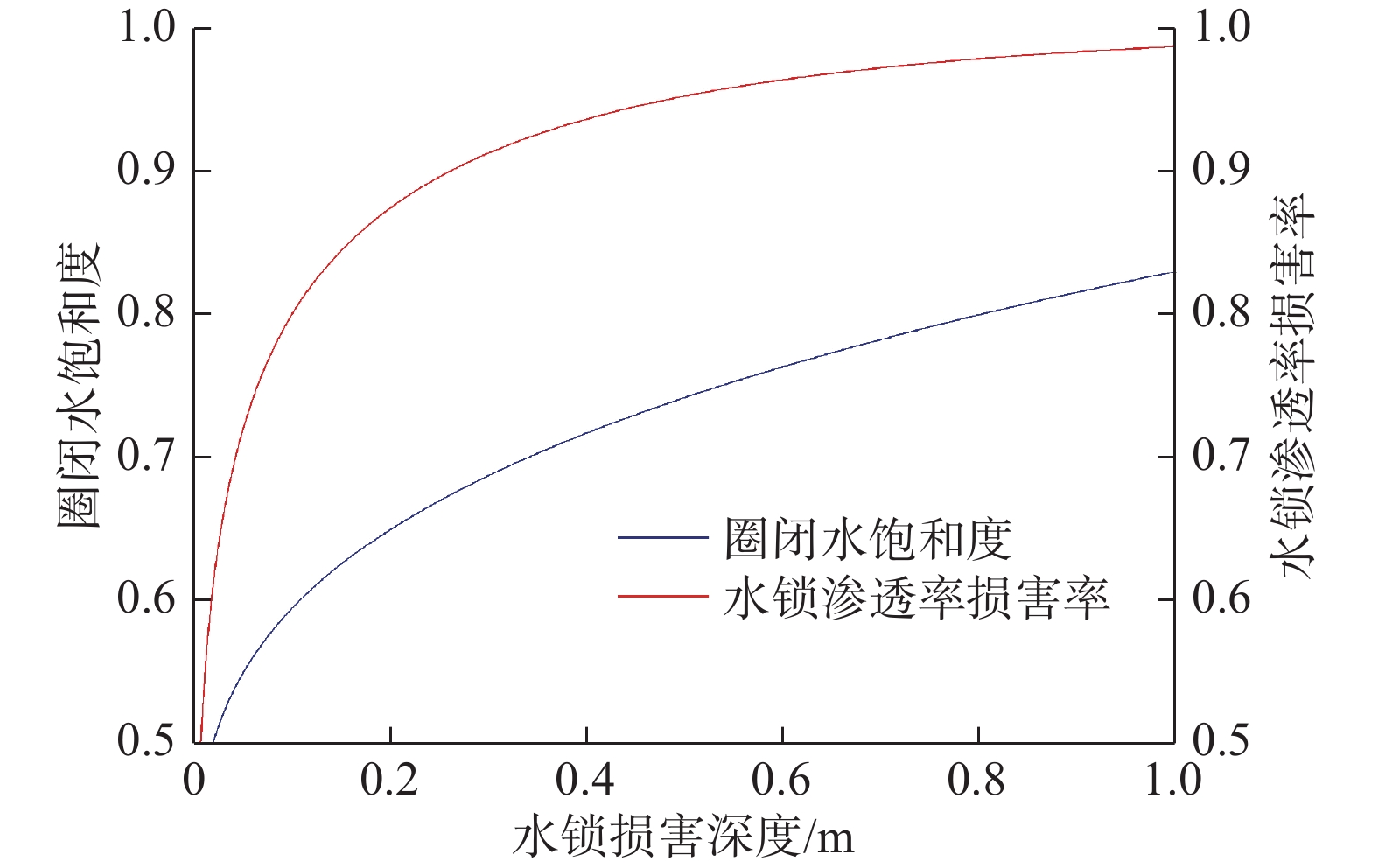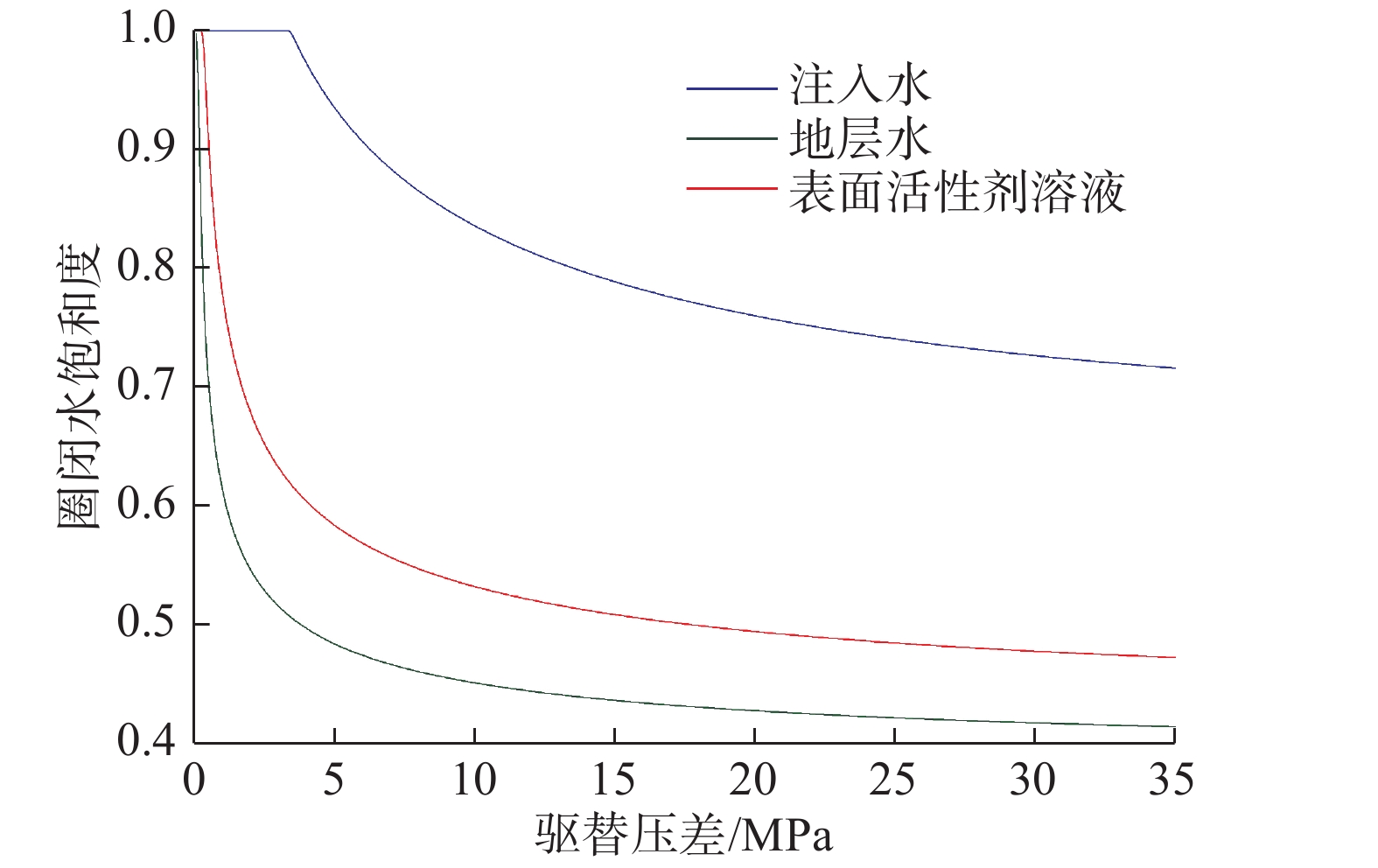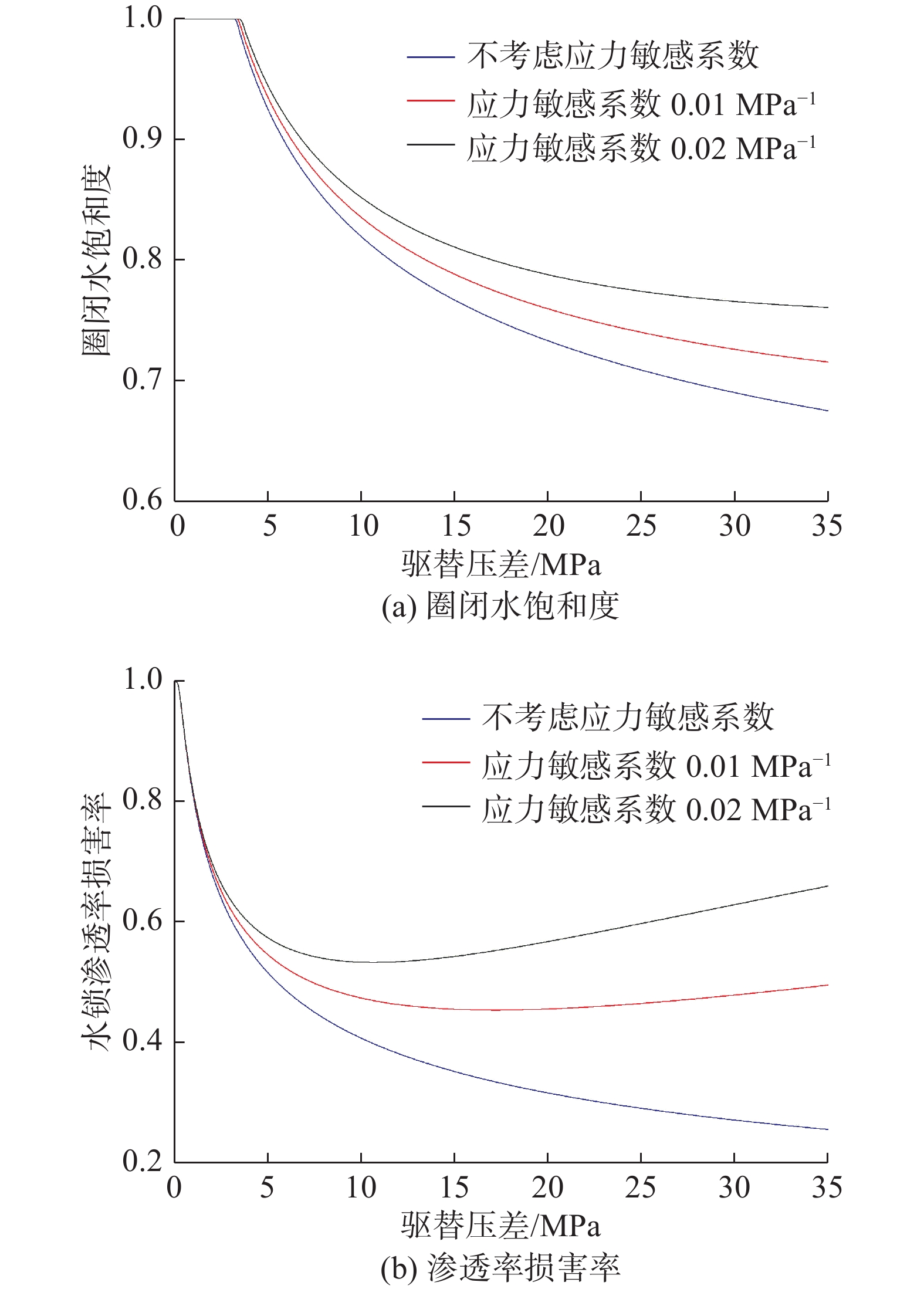Quantitative Evaluation Model of Water Blocking Damage in Low Permeability Gas Reservoirs
-
摘要:
为了定量评价低渗透气藏潜在的水锁损害,基于相对渗透率和启动压力梯度模型,建立了低渗透气藏水锁损害定量评价模型,分析了水锁损害深度、启动压力梯度和应力敏感对水锁损害程度的影响。分析发现,该模型的预测结果与致密砂岩水锁损害实验结果吻合较好;水锁损害深度越大,潜在的水锁损害程度越严重;流体启动压力梯度越大,液相越难以返排,添加表面活性剂能够提高流体返排效率;高返排压差有利于液相返排,但应力敏感可能导致水锁损害程度增大,在启动压力梯度较低时影响尤其明显。研究结果表明,水锁损害是水相滞留引起的气相相对渗透率降低与应力敏感导致的绝对渗透率降低协同作用的结果,确定合理的返排压差能够减轻水锁对低渗透气藏的损害。
Abstract:In this study, the goal was to quantitatively evaluate the potential water locking damage in low permeability gas reservoirs. To do so, a quantitative evaluation model for water locking damage in low permeability gas reservoirs was established based on the relative permeability and starting pressure gradient models. In the doing so, we analyzed the influences of water locking damage depth, starting pressure gradient and stress sensitivity on the water blocking damage degree. The analysis results suggested that the predicted results are better matched with the data of water locking damage experiment in tight sandstone. The greater the depth of water locking damage, the more serious the potential water locking damage; the larger the fluid starting pressure gradient, the more difficult for the liquid phase to cleanup. Herethe fluid cleanup efficiency could be improved by adding surfactant. A cleanup differential pressure is beneficial to liquid phase cleanup, while stress sensitivity may exaggerate the water locking damage, especially when the starting pressure gradient is low. Studies showed that water locking damage is the synergistic effect of reduced gas phase relative permeability caused by water phase retention and reduced absolute permeability caused by stress sensitivity, and the reasonably determined cleanup differential pressure is conducive to alleviating the water locking damage in low permeability gas reservoirs.
-
低渗透气藏孔隙结构复杂、连通性差,钻井完井及储层改造过程中易受到液相侵入损害[1–3]。由于孔隙吼道细小,固相侵入损害深度及其程度有限,损害类型以水锁损害为主[4]。水相在正压差或毛管力作用下侵入气层,导致侵入带水相饱和度增大,造成气相有效渗透率显著减低。由于低渗透气藏毛细管力较强,侵入的液相容易被吸附并滞留在毛细管孔隙中,造成气井低产甚至无产[5–6]。压裂改造作为提高低渗透气藏单井产能的主要方法,但效果往往并不理想,甚至可能适得其反[7]。
水锁损害评价方法主要包括渗透率损害率法、水相圈闭指数法(APTi)、修正水相圈闭指数法(MAPTi)、总水体积法(BVW)、相圈闭系数法(PTC)和相圈闭指数法(PTI)[8–12]、回归分析法、灰色预测法、孔隙结构分形、神经网络法和灰色–神经网络法等[13–14]。这些方法是基于实验数据的拟合结果,可以定性评价水锁损害程度,不能定量评价水锁损害程度,且没有考虑影响水锁损害的主要因素。PTI指数法考虑了流体侵入过程对水锁损害的影响,但没有考虑流体返排的影响[11]。
侵入地层的流体能否返排与气藏的启动压力梯度有关,因此,评价水锁损害需同时考虑液相的侵入过程与返排过程。为此,笔者基于水相相对渗透率模型和启动压力梯度模型,建立了水锁损害定量评价模型,在验证模型可行性的基础上,分析了水锁损害深度、启动压力梯度和应力敏感对水锁损害程度的影响。
1. 水锁损害定量评价模型的建立
对于含水饱和度一定的岩心,只有当压力梯度超过某一定值后,气体才开始流动,表现出启动压力梯度。对于低渗透气藏,侵入液相能够返排的临界条件为:
dpdx=λp (1) 式中:p为压力,Pa;x为距离,m;λp为启动压力梯度,Pa/m。
流体启动压力梯度与岩心的渗透率、流体性质、水相饱和度以及孔隙结构特征等有关,采用A. Prada等人[15]提出的启动压力梯度与流度的经验公式对实验数据进行拟合,进而预测启动压力梯度。计算公式为:
λp=m(Kμ)−n (2) 式中:K为渗透率,mD;μ为流体黏度,Pa·s;m为实验数据拟合系数,Pa/m;n为拟合指数。
采用Brook-Corey模型[14]计算水相渗透率:
Krw=(Sw−Swcw1−Swcw)2+3λλ (3) 式中:Krw为水相相对渗透率;λ为孔隙特征表征常数;Sw为水相饱和度;Swcw为水相流动的临界水饱和度。
J. M. Dacy研究指出[16],根据测试的致密砂岩毛细管压力,利用式(3)计算的水相相对渗透率与实验测试的拟合程度较好。根据式(2)和式(3)可求得一定驱替压力下的圈闭水饱和度,计算公式为:
Swt=Swcw+(1−Swcw)[μwKw(1mΔpΔx)−1n]λ2+3λ (4) 式中:Swt为圈闭水饱和度;
Δp 为驱替压差,Pa;Δx 为水锁损害深度,m;Kw为水相饱和度为100%时的水相渗透率,mD。求得一定驱替压力下的圈闭水饱和度后,可以根据气相相对渗透率曲线计算圈闭水饱和度下的气相相对渗透率。J. M. Dacy建议[16]采用下式计算低渗透气藏气相相对渗透率:
Krg=(1−Sw−Swcg1−Sgc−Swcg)ng (5) 式中:Krg为气相相对渗透率;Sgc为临界气相饱和度;Swcg为气相流动的临界水饱和度;ng为气相相对渗透率拟合系数。
根据式(4)计算一定驱替压力下的圈闭水饱和度,然后代入式(5)计算圈闭水饱和度下的气相相对渗透率,进而求得水锁引起的渗透率损害率。计算公式为:
Dpt=1−KgSwtKgSwi=1−KrgSwtKrgSwi (6) 式中:Dpt为水锁引起的渗透率损害率;KgSwt为圈闭水饱和度下的气相渗透率,mD;KgSwi为初始水相饱和度下的气相渗透率,mD;KrgSwt为圈闭水饱和度下的气相相对渗透率;KrgSwi为初始水相饱和度下的气相相对渗透率。
驱替压力下考虑应力敏感的渗透率为[4]:
K=Kie−α(pi−p) (7) 式中:Ki为初始渗透率,mD;pi为初始压力,Pa;p为压力,Pa;α为应力敏感系数,Pa–1。
因此,根据式(6)和式(7),考虑应力敏感损害,水锁引起的渗透率损害率可以表示为:
Dpt=1−KrgSwtKrgSwie−α(pi−p) (8) 2. 模型可行性验证
采用式(4)计算圈闭水饱和度时,需确定参数m和n。采用最小二乘法对Zeng Baoquan等人[17]测试的致密砂岩岩样启动压力梯度数据进行拟合,结果如图1所示。双对数坐标图中的直线为式(2)拟合结果,拟合参数m和n见表1。对于实验注入水,拟合的m和n分别为0.240 MPa/m和1.141,决定系数R2为0.913,均方根误差为0.170 MPa/m,说明式(2)与实验结果拟合较好。注入水的拟合参数远大于地层水与表面活性剂溶液,说明添加表面活性剂可降低流体的启动压力梯度,能在一定程度上增强侵入流体的返排效果。
表 1 参数拟合结果Table 1. The results of parameters fitting编号 μ/(mPa·s) m/(MPa·m–1) n R2 均方根误差/
(MPa·m–1)注入水 0.850 0.240 1.141 0.913 0.170 地层水 0.910 0.053 0.872 0.975 0.013 表面活性剂溶液 0.930 0.025 0.779 0.926 0.020 采用式(4)计算圈闭水饱和度,并与致密砂岩岩样水锁损害实验测试结果对比。实验数据包括游利军等人[18]、朱华银等人[19]、S.Y.Mo等人[20]与李海波[21]测试的实验结果,岩心基本参数见表2,其中岩心实验水锁损害深度
Δx 取岩心长度。实验测试结果与圈闭水饱和度模型(即式(4))计算结果对比情况如图2所示。表 2 致密砂岩基本参数Table 2. Basic parameters of tight sandstone序号 流体 岩样号 Kw/mD Φ,% Δx/cm R2 均方根误差/(MPa·m–1) 1 注入水 S3 0.181 3.070 6.450 0.992 0.006 2 S2-29 0.689 12.000 4.480 0.919 0.036 3 S2-75 0.144 5.900 4.459 0.980 0.005 4 S9 0.054 3.160 2.620 0.962 0.016 5 S2 0.217 5.280 2.810 0.913 0.028 6 模拟地层水 Z16-5 0.058 7.560 6.580 0.981 0.006 7 S240-8 0.091 9.860 5.820 0.981 0.003 8 T39-5 0.082 9.270 5.770 0.818 0.010 从图2可知,随着驱替压差增大,圈闭水饱和度降低,但随驱替压差增大,圈闭水饱和度降低幅度越来越小,说明降低圈闭水饱和度更为困难。相同情况下,渗透率越小,圈闭水饱和度越大。R2越大,均方根误差越小,表明模型预测效果越好。由表2可知,模型计算结果与实验值吻合较好,因此可以用该模型计算给定条件下的圈闭水饱和度。
3. 评价方法对比
对比分析常用的水锁损害评价方法计算结果,具体计算方法见文献[7–10]。砂岩岩心渗透率为0.058 mD,孔隙度为7.56%,表面张力为72.0 mN/m,接触角为0°,驱替压差为4.05 MPa,气藏压力为40.00 MPa,水相黏度为0.869 mPa·s,气相黏度为0.027 mPa·s,初始水相饱和度为0.300,束缚水饱和度为0.586。不同方法计算的评价指标对比结果如表3所示,渗透率测试和PTC方法表明水锁程度强,而APTi、MAPTi和BVW方法显示水锁程度为中等。上述方法均属于稳态评价方法,结果与作用时间无关,且只依赖于初始含水饱和度与束缚水饱和度。
表 3 不同方法计算的评价指标对比Table 3. Comparison on the results of different evaluation methods计算方法 计算结果 损害程度 Dpt 0.82 强 APTi 0.43 中等 MAPTi 0.22 中等 BVW 2.27 中等 PTC 0.97 强 相圈闭指数法考虑了作业时间对水锁损害程度的影响,PTI指数小于0.25时水锁损害程度较弱,PTI指数为0.25~0.50时水锁损害程度中等,PTI指数为0.50~0.75时水锁损害程度强,PTI指数为0.75~1.00时水锁损害程度严重(见图3)。从图3可以看出,作业时间少于3 h时,水锁损害程度中等;作业时间一旦超过16 h,水锁损害程度严重。
4. 水锁影响因素分析
水锁损害深度、启动压力梯度和应力敏感等对圈闭水饱和度和水锁引起渗透率损害率的影响都较大,因此,分析了这3种因素的影响。
4.1 水锁损害深度
水锁损害深度对圈闭水饱和度及渗透率损害率的影响结果如图4所示。从图4可以看出,水锁损害深度越大,圈闭水饱和度越大,相应的渗透率损害率越高。损害深度较小时,渗透率损害率的增加十分明显;而当损害深度增加到一定程度时,圈闭水饱和度明显增大,但渗透率损害率未显著升高,这与气液两相相对渗透率曲线的形状有关。
4.2 启动压力梯度
注入水、地层水和表面活性剂溶液在不同驱替压差下的圈闭水饱和度如图5所示,3种流体的启动压力梯度拟合参数m和n取值见表1。由表1可知,注入水的启动压力梯度最大,地层水次之,表面活性剂溶液最小。从图5可以看出,在相同驱替压差下,启动压力梯度最大的注入水难以返排,对应的圈闭水饱和度最大,表面活性剂溶液对应的圈闭水饱和度最小。
4.3 应力敏感
应力敏感对圈闭水饱和度的影响结果如图6所示。从图6可以看出:考虑应力敏感时,应力敏感系数越大,圈闭水饱和度越大,气相有效渗透率就越小,水锁损害程度越严重;考虑应力敏感时,渗透率损害率随驱替压差增大呈先降低后升高的趋势,且应力敏感系数越大,变化趋势越明显。
5. 结 论
1)基于水相相对渗透率和启动压力梯度模型,建立了低渗透气藏圈闭水饱和度评价模型;结合气相相对渗透率模型,能够定量评价水锁引起的渗透率损害率;通过致密砂岩水锁损害实验验证了模型的可行性,结果表明模型评价结果与实验测试结果吻合较好。
2)水锁损害评价需同时考虑液相侵入过程与流体返排过程;液相侵入损害深度越大,水锁损害程度越严重;流体启动压力梯度越大,潜在的水锁损害程度越高,添加表面活性剂能够提高流体返排效率,降低水锁损害程度。
3)水锁损害是气相相对渗透率降低与应力敏感导致的绝对渗透率降低共同作用的结果,增大返排压差能够降低圈闭水饱和度,但应力敏感造成地层绝对渗透率降低,对于应力敏感系数较大的地层返排压差过大可能导致水锁损害程度增加。
-
表 1 参数拟合结果
Table 1 The results of parameters fitting
编号 μ/(mPa·s) m/(MPa·m–1) n R2 均方根误差/
(MPa·m–1)注入水 0.850 0.240 1.141 0.913 0.170 地层水 0.910 0.053 0.872 0.975 0.013 表面活性剂溶液 0.930 0.025 0.779 0.926 0.020 表 2 致密砂岩基本参数
Table 2 Basic parameters of tight sandstone
序号 流体 岩样号 Kw/mD Φ,% Δx/cm R2 均方根误差/(MPa·m–1) 1 注入水 S3 0.181 3.070 6.450 0.992 0.006 2 S2-29 0.689 12.000 4.480 0.919 0.036 3 S2-75 0.144 5.900 4.459 0.980 0.005 4 S9 0.054 3.160 2.620 0.962 0.016 5 S2 0.217 5.280 2.810 0.913 0.028 6 模拟地层水 Z16-5 0.058 7.560 6.580 0.981 0.006 7 S240-8 0.091 9.860 5.820 0.981 0.003 8 T39-5 0.082 9.270 5.770 0.818 0.010 表 3 不同方法计算的评价指标对比
Table 3 Comparison on the results of different evaluation methods
计算方法 计算结果 损害程度 Dpt 0.82 强 APTi 0.43 中等 MAPTi 0.22 中等 BVW 2.27 中等 PTC 0.97 强 -
[1] 赵宏波, 贾进孝, 孟令涛, 等. 一种新型降水锁洗井液NDF-1的性能评价及现场试验[J]. 石油钻探技术, 2015, 43(6): 87–92 http://d.old.wanfangdata.com.cn/Periodical/syztjs201506016 ZHAO Hongbo, JIA Jinxiao, MENG Lingtao, et al. Performance evaluation and field application of a novel water lock reducing flushing fluid DNF-1[J]. Petroleum Drilling Techniques, 2015, 43(6): 87–92 http://d.old.wanfangdata.com.cn/Periodical/syztjs201506016
[2] YANG Xu, MENG Yingfeng, SHI Xiangchao, et al. Influence of porosity and permeability heterogeneity on liquid invasion in tight gas reservoirs[J]. Journal of Natural Gas Science and Engineering, 2017, 37: 169–177 doi: 10.1016/j.jngse.2016.11.046
[3] 韩成,黄凯文,韦龙贵,等. 海上低渗储层防水锁强封堵钻井液技术[J]. 钻井液与完井液, 2018, 35(5): 67–71 HAN Cheng, HUANG Kaiwen, WEI Longgui, et al. A drilling fluid with water block preventive capacity and strong plugging capacity for offshore low permeability reservoir drilling[J]. Drilling Fluid & Completion Fluid, 2018, 35(5): 67–71
[4] 杨旭, 孟英峰, 李皋, 等. 考虑水锁损害的致密砂岩气藏产能分析[J]. 天然气地球科学, 2017, 28(5): 812–818 http://d.old.wanfangdata.com.cn/Periodical/trqdqkx201705016 YANG Xu, MENG Yingfeng, LI Gao, et al. Productivity analysis of tight sandstone gas reservoirs considering water blocking damage[J]. Natural Gas Geoscience, 2017, 28(5): 812–818 http://d.old.wanfangdata.com.cn/Periodical/trqdqkx201705016
[5] 韦青, 李治平, 白瑞婷, 等. 微观孔隙结构对致密砂岩渗吸影响的试验研究[J]. 石油钻探技术, 2016, 44(5): 109–116 http://d.old.wanfangdata.com.cn/Periodical/syztjs201605019 WEI Qing, LI Zhiping, BAI Ruiting, et al. An experimental study on the effect of microscopic pore structure on spontaneous imbibition in tight sandstones[J]. Petroleum Drilling Techniques, 2016, 44(5): 109–116 http://d.old.wanfangdata.com.cn/Periodical/syztjs201605019
[6] 唐洪明, 朱柏宇, 王茜, 等. 致密砂岩气层水锁机理及控制因素研究[J]. 中国科学: 技术科学, 2018, 48(5): 537–547 http://www.cnki.com.cn/Article/CJFDTOTAL-JEXK201805008.htm TANG Hongming, ZHU Baiyu, WANG Xi, et al. Mechanism and control factors of water blocking in tight sandstone gas reservoir[J]. Scientia Sinica (Technologica), 2018, 48(5): 537–547 http://www.cnki.com.cn/Article/CJFDTOTAL-JEXK201805008.htm
[7] 唐洪明, 徐诗雨, 王茜, 等. 克拉苏气田超致密砂岩气储层水锁损害[J]. 断块油气田, 2017, 24(4): 541–545 http://d.old.wanfangdata.com.cn/Periodical/dkyqt201704023 TANG Hongming, XU Shiyu, WANG Xi, et al. Water blocking damage of hyper-tight sandstone gas reservoir in Kelasu Gas Field[J]. Fault-Block Oil & Gas Field, 2017, 24(4): 541–545 http://d.old.wanfangdata.com.cn/Periodical/dkyqt201704023
[8] BENNION D B, THOMAS F B, BIETZ R F, et al. Water and hydrocarbon phase trapping in porous media-diagnosis, prevention and treatment[J]. Journal of Canadian Petroleum Technology, 1996, 35(10): 29–36
[9] DAVIS B B J, WOOD W D. Maximizing economic return by minimizing or preventing aqueous phase trapping during completion and stimulation operations[R]. SPE 90170, 2004.
[10] YOU Lijun, KANG Yili. Integrated evaluation of water phase trapping damage potential in tight gas reservoirs[R]. SPE 122034, 2009.
[11] SABOORIAN-JOOYBARI H, POURAFSHARY P. Potential severity of phase trapping in petroleum reservoirs: an analytical approach to prediction[R]. SPE 183631, 2016.
[12] 王茜,王双威,唐胜蓝,等. 基于致密砂岩气藏初始含水饱和度的水锁伤害评价[J]. 钻井液与完井液, 2017, 34(6): 41–45 doi: 10.3969/j.issn.1001-5620.2017.06.008 WANG Xi, WANG Shuangwei, TANG Shenglan, et al. Permeability impairment by water block in tight sandstone gas reservoirs with Initial water saturation[J]. Drilling Fluid & Completion Fluid, 2017, 34(6): 41–45 doi: 10.3969/j.issn.1001-5620.2017.06.008
[13] 蒋官澄, 王晓军, 关键, 等. 低渗特低渗储层水锁损害定量预测方法[J]. 石油钻探技术, 2012, 40(1): 69–73 doi: 10.3969/j.issn.1001-0890.2012.01.014 JIANG Guancheng, WANG Xiaojun, GUAN Jian, et al. The quantitative prediction method of water blocking damage in low and extra-low permeability reservoir[J]. Petroleum Drilling Techniques, 2012, 40(1): 69–73 doi: 10.3969/j.issn.1001-0890.2012.01.014
[14] 张益, 李军刚, 佟晓华, 等. 基于神经网络信息融合技术预测气藏水锁[J]. 特种油气藏, 2011, 18(2): 102–103, 110 doi: 10.3969/j.issn.1006-6535.2011.02.029 ZHANG Yi, LI Jungang, TONG Xiaohua, et al. Prediction of water lock in gas reservoirs based on neural network information fusion[J]. Special Oil & Gas Reservoirs, 2011, 18(2): 102–103, 110 doi: 10.3969/j.issn.1006-6535.2011.02.029
[15] PRADA A, CIVAN F. Modification of Darcy′s law for the threshold pressure gradient[J]. Journal of Petroleum Science and Engineering, 1999, 22(4): 237–240 doi: 10.1016/S0920-4105(98)00083-7
[16] DACY J M. Core tests for relative permeability of unconventional gas reservoirs[R]. SPE 135427, 2010.
[17] ZENG Baoquan, CHENG Linsong, HAO Fei. Experiment and mechanism analysis on threshold pressure gradient with different fluids[R]. SPE 140678, 2010.
[18] 游利军, 石玉江, 张海涛, 等. 致密砂岩气藏水相圈闭损害自然解除行为研究[J]. 天然气地球科学, 2013, 24(6): 1214–1219 http://d.old.wanfangdata.com.cn/Periodical/trqdqkx201306015 YOU Lijun, SHI Yujiang, ZHANG Haitao, et al. Spontaneous removal behavior of water phase trapping damage in tight sandstone gas reservoirs[J]. Natural Gas Geoscience, 2013, 24(6): 1214–1219 http://d.old.wanfangdata.com.cn/Periodical/trqdqkx201306015
[19] 朱华银, 徐轩, 安来志, 等. 致密气藏孔隙水赋存状态与流动性实验[J]. 石油学报, 2016, 37(2): 230–236 doi: 10.3969/j.issn.1001-8719.2016.02.002 ZHU Huayin, XU Xuan, AN Laizhi, et al. An experimental on occurrence and mobility of pore water in tight gas reservoirs[J]. Acta Petrolei Sinica, 2016, 37(2): 230–236 doi: 10.3969/j.issn.1001-8719.2016.02.002
[20] MO S Y, HE S L, LEI G, et al. Effect of the drawdown pressure on the relative permeability in tight gas: a theoretical and experimental study[J]. Journal of Natural Gas Science and Engineering, 2015, 24: 264–271 doi: 10.1016/j.jngse.2015.03.034
[21] 李海波. 岩心核磁共振可动流体T2截止值实验研究[D]. 北京: 中国科学院渗流流体力学研究所, 2008: 20-24. LI Haibo. Core experimental study of NMR T2 cutoff value[D]. Beijing: Chinese Academy of Sciences, Institute of Porous Flow and Fluid Mechanics, 2008: 20-24.
-
期刊类型引用(1)
1. 何雨,孟鐾桥,郑友志,吴柄燕,赵军,李斌. 渝西区块页岩气钻井防漏堵漏技术研究. 石油工业技术监督. 2023(07): 58-62 .  百度学术
百度学术
其他类型引用(0)














 下载:
下载:












